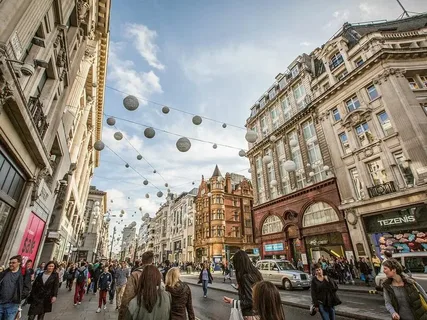The end of an era for a tourist staple
Cool Britannia, a vibrant fixture of London tourism and retail, is shutting the doors of its flagship store on Oxford Street. Known for its quintessentially British souvenirs and iconic memorabilia, the retailer has long drawn in visitors looking to take a piece of the UK home with them. But now, Cool Britannia is the latest in a growing list of shops to exit Europe’s busiest shopping thoroughfare, marking another sobering chapter in the saga of the British high street’s ongoing challenges.
A poignant moment for Oxford Street
The news broke quietly, with a passerby posting an image of the store’s closing down sale signs to social media. The user described the scene as a “sad status report,” reflecting broader concerns about the health of the UK’s retail industry. Although Cool Britannia continues to operate stores near Whitehall, Buckingham Palace, and in cities like Liverpool and Oxford, the closure of its Oxford Street location hits differently. It underscores not just a changing consumer landscape, but the shifting cultural dynamics of one of the world’s most iconic retail streets.
Oxford Street: The jewel of British retail
From retail paradise to economic battleground
Oxford Street has long been synonymous with British commerce. Attracting millions of tourists and locals each year, the street is lined with flagship stores from fashion giants, tech brands, and department store mainstays. Yet the street’s identity has become more fragile in recent years. Foot traffic has declined post-pandemic, business rents remain high, and shoppers are increasingly pivoting to online retail options.
A list of high-profile exits
The closure of Cool Britannia follows the departure of Microsoft, which shut its massive 21,000-square-foot store on Oxford Street in February. Opened in 2019, the tech company claimed its decision was a strategic move toward digital growth. But Microsoft wasn’t alone. Retailers such as Gap, TM Lewin, Sports Direct, and House of Fraser have all shuttered their Oxford Street locations in recent years. These exits are not isolated incidents—they reflect a broader contraction of physical retail presences across the UK.
Vacancy rate: A mixed signal
Interestingly, despite these high-profile closures, Oxford Street’s vacancy rate has recently improved. As of early 2025, only 2% of shopfronts on the street are reported to be vacant—the lowest figure in several years. However, that statistic may be misleading. According to reports from The Sun, even popular brands like Urban Outfitters, Zara, and River Island may be forced to relocate or close as building owners contemplate lease exits and renovations.
This means that while Oxford Street may appear resilient on paper, the reality for many retailers is still uncertain.
The broader retail collapse across the UK
Nationwide closures accelerate
Cool Britannia’s Oxford Street closure is part of a national trend. Retailers like New Look, Select Fashion, and WHSmiths are also trimming their physical presence, planning multiple store closures in 2025. A staggering 13,000 high street stores shuttered across the UK in 2024—a more than 25% increase over the previous year. While many of these closures affected small businesses, major retail chains have not been immune. Ted Baker and Carpetright are just two well-known names among the casualties.
What’s driving the decline?
Several key factors are contributing to the collapse
- Digital transformation: Online shopping continues to grow, with consumers valuing convenience and lower prices.
- Economic pressure: Inflation, rising utility costs, and interest rates have squeezed both businesses and shoppers.
- Changing habits: The post-pandemic shift to hybrid work has reduced weekday footfall in city centers.
All of these pressures are converging to reshape the future of brick-and-mortar retail.
The government’s response
The Spring 2025 economic forecast offered little optimism. Chancellor Rachel Reeves confirmed that the UK’s projected economic growth has been halved—from 2% down to just 1%. That downgrade further underscores the fragile state of consumer confidence and spending power. Retail experts have warned that, despite the mass closures of 2024, the worst may still lie ahead.
In response, some political leaders have called for tax breaks or financial support for struggling high street businesses. But so far, tangible assistance has been limited, leaving many independent retailers to fend for themselves.
Cool Britannia’s quiet legacy
Cool Britannia has long been a cultural icon for tourists. Its playful merchandise, Union Jack-themed gifts, and London-centric branding captured the imagination of countless visitors. The Oxford Street location, in particular, was more than just a store—it was an experience. Stepping inside was like entering a miniature, cheeky version of British pop culture.
Its closure doesn’t just signal the end of one store, but perhaps the fading of a certain kind of retail charm—the kind that relies not just on products, but on place.
What comes next for Oxford Street?
A potential revival or further decline?
With fewer international tourists and increased competition from online platforms, Oxford Street may be forced to reinvent itself. Retail experts suggest a mixed-use future—one where experiential spaces, dining, entertainment, and co-working areas supplement traditional stores. Some real estate developers are already pivoting in that direction, planning multi-purpose buildings instead of retail-only structures.
However, transformation takes time—and investment. And in the interim, the closures may continue.
Final thoughts: A symbol of retail in transition
Cool Britannia’s Oxford Street store was more than a place to buy keychains and T-shirts. It was a representation of London’s unique ability to fuse tourism and commerce. Its loss, while not catastrophic, is emblematic of a deeper malaise affecting high streets not just in London, but across the UK.
As 2025 unfolds, more brands may follow suit—either retreating to e-commerce, relocating to smaller spaces, or disappearing altogether. Whether Oxford Street can weather this storm and reclaim its retail glory remains to be seen.
For now, all that remains is a store window full of red sale signs—and a lingering question about what the future holds for the heart of British shopping culture.
- Bonnie Blue secretly filming huge C4 show which will reveal ‘what her life’s really like’ after 1,000 men sex stunt - June 5, 2025
- When is Mother’s Day 2025 in the UK? Origins and global celebration dates - June 5, 2025
- Who is Dave Blunts? The ghostwriter rapper behind Kanye West’s new album - June 5, 2025







